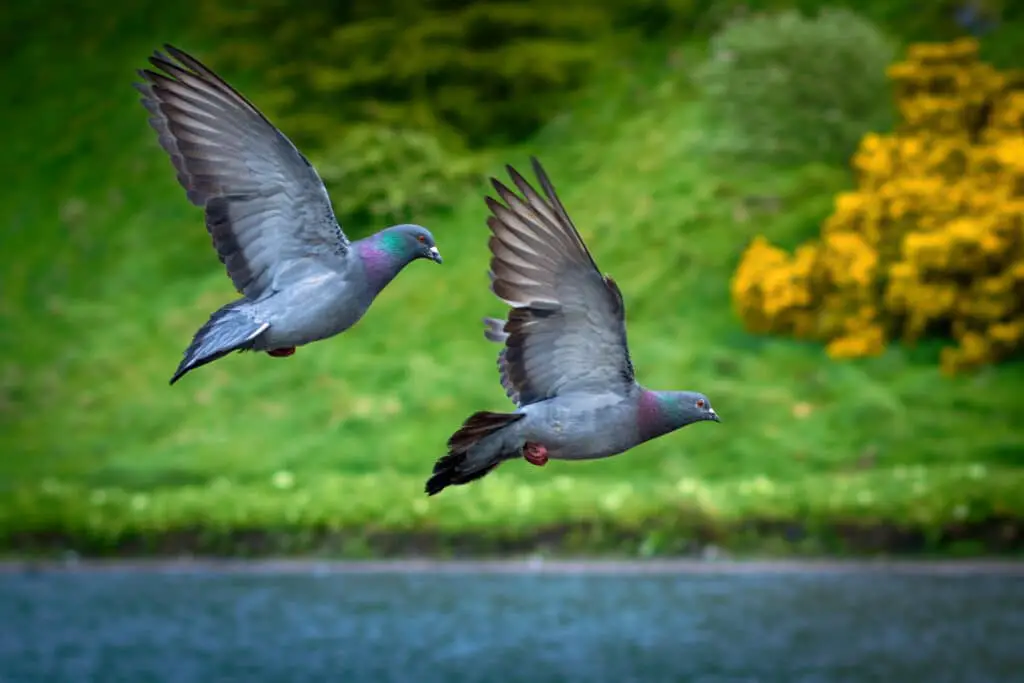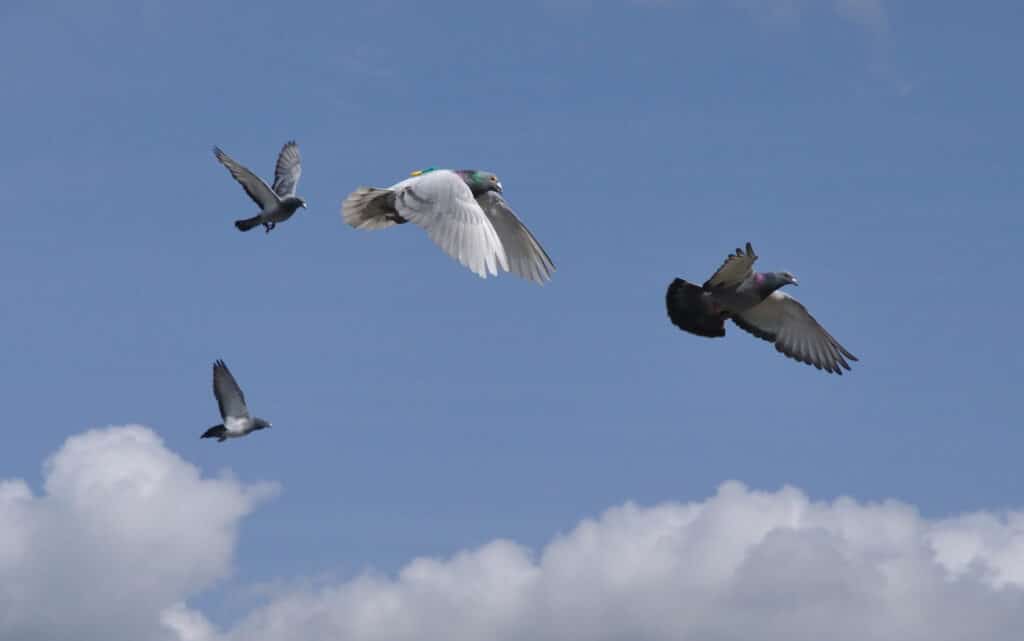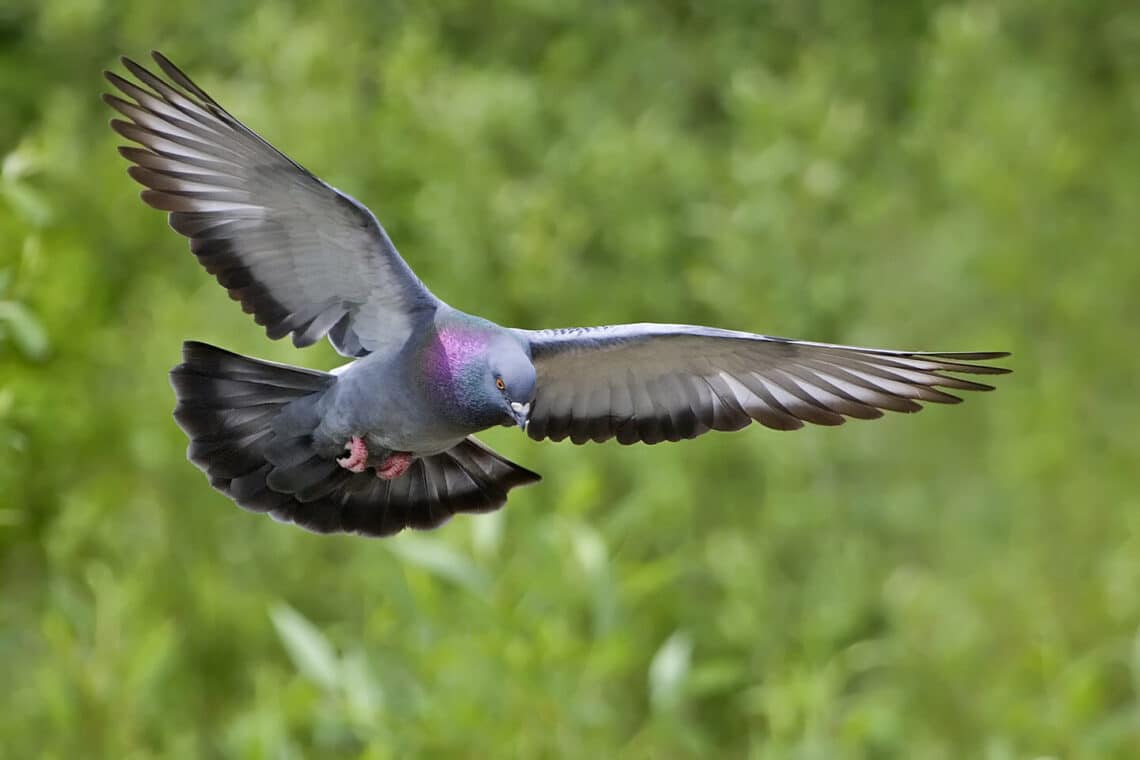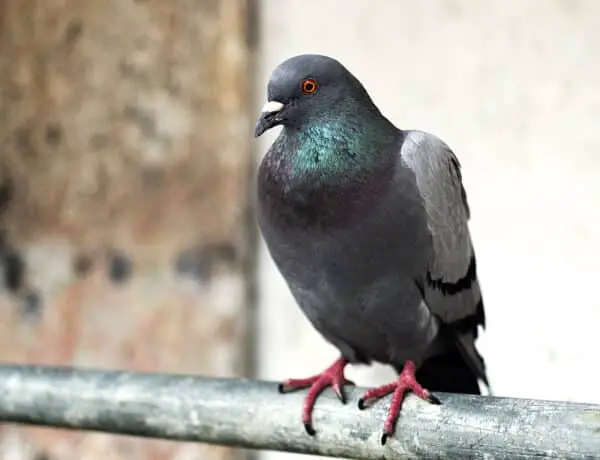Introduction
How Far Can Homing Pigeons Fly: The enigmatic abilities of homing pigeons have captivated human imagination for centuries. These remarkable birds possess an extraordinary talent for navigation, flying vast distances with unwavering precision to return to their home lofts. The question that has intrigued scientists, pigeon enthusiasts, and curious minds alike is: just how far can homing pigeons fly?
Homing pigeons, scientifically known as Columba livia domestica, have a storied history dating back thousands of years. Revered for their unparalleled navigational skills, they were employed as vital messengers in times of war, and their feats have become the stuff of legend. But what are the limits of their incredible flight range, and how do they manage to find their way back home across seemingly insurmountable distances? In this exploration, we will embark on a journey into the world of homing pigeons, unveiling the astonishing distances they can cover and shedding light on the mysteries that shroud their homing abilities.
As we venture into the skies with these avian navigators, we will delve deep into the science and secrets behind their incredible feats, discovering how they push the boundaries of what we thought possible for a bird’s homing capabilities. So, fasten your seatbelts and prepare to soar alongside these extraordinary birds as we uncover the fascinating question: How far can homing pigeons lay fly?

How far will homing pigeons fly home?
If taken away from home, though, they can find their way back home in a remarkably short period of time. In fact, homing pigeons have been known to find their way home from as many as 1,100 miles away, and they can travel an average of 50 miles per hour with bursts of up to 90 mph.
Homing pigeons, particularly those that have been selectively bred and trained for their homing abilities, can fly impressive distances to return to their home lofts. The distance they can cover in a homing flight can vary depending on several factors, including their training, physical condition, and environmental conditions. Here are some general guidelines:
Racing Pigeons: Racing pigeons, which are bred and trained for long-distance races, can cover distances of approximately 600 to 700 miles (965 to 1,126 kilometers) or more in a single race when conditions are favorable. Some exceptional racing pigeons have been known to fly even greater distances.
Non-Racing Pigeons: Pigeons that are not specifically trained for racing purposes may not cover such extensive distances. They often forage for food within a few miles of their home lofts and may not undertake long-distance flights.
Training and Familiarity: The pigeons’ familiarity with the route and the loft’s location plays a significant role. Pigeons that have been raised and trained at a particular loft are more likely to find their way back over longer distances.
Weather Conditions: Weather, including wind speed and direction, can impact a pigeon’s ability to cover long distances. Favorable wind conditions can assist pigeons in reaching their destination more quickly.
Health and Condition: A pigeon’s physical condition and overall health also influence its ability to complete long homing flights. Healthy pigeons are better equipped to handle the physical demands of extended flights.
How far can a homing pigeon fly without stopping?
Homing pigeons can fly hundreds of miles without stopping for McDonald’s or taking gas station rest breaks. Weighing just a pound, pigeons can fly 500 to 800 miles a day at more than 60 mph. In ancient times, homing pigeons could fly only about 100 miles a day.
The distance a homing pigeon can fly without stopping depends on several factors, including the individual pigeon’s physical condition, training, weather conditions, and the specific circumstances of the flight. Homing pigeons, especially those bred and trained for long-distance racing, can cover impressive distances without stopping. Here are some general guidelines:
Racing Pigeons: Racing pigeons, which are selectively bred and trained for endurance and navigation, can fly approximately 600 to 700 miles (965 to 1,126 kilometers) or more in a single race when conditions are favorable. These races often require pigeons to cover significant distances without stopping.
Non-Racing Pigeons: Pigeons that are not specifically trained for long-distance racing are less likely to cover such extensive distances without stopping. They typically forage for food and rest intermittently during their flights.
Weather Conditions: Favorable weather conditions, including clear skies, mild temperatures, and calm winds, can enable pigeons to cover longer distances without fatigue. Adverse weather conditions, such as strong headwinds, can significantly limit their flying range.
Training and Conditioning: Racing pigeons are rigorously trained for endurance and navigation. They become familiar with the routes they will race and learn to pace themselves effectively, which allows them to cover longer distances without stopping.
What is the farthest a homing pigeon has ever flown?
It is claimed that the greatest long-distance flight recorded by a pigeon is one that started at Arras in France and ended in Saigon, Vietnam, back in 1931, according to pigeonpedia.com. The distance was 11,600 kilometers (7,200 miles) and took 24 days.
The farthest distance a homing pigeon has ever flown is a matter of historical record and has been well-documented in various pigeon racing competitions and scientific studies. While there may be individual instances of pigeons covering extraordinary distances, one of the most famous cases is that of a pigeon named “G.I. Joe.”
During World War II, G.I. Joe, a homing pigeon, was credited with a heroic flight on October 18, 1943. G.I. Joe was part of the British Army Pigeon Service and carried a critical message that helped avert a potential friendly fire incident between British and American forces in Italy. The pigeon flew a distance of approximately 20 miles (32 kilometers) in just 20 minutes, from the village of Calvi Vecchia to the Allied command post in Bari, Italy. This flight is often cited as one of the longest and most famous single pigeon flights in history.
However, it’s important to note that homing pigeons have been known to cover much greater distances in pigeon racing competitions, with some pigeons flying hundreds of miles in a single race. The distance a homing pigeon can fly depends on various factors, including their training, condition, and the specific race conditions.
Can pigeons find their way home?
In fact, homing pigeons have been known to find their way home from as many as 1,100 miles away, and they can travel an average of 50 miles per hour with bursts of up to 90 mph! This ability has made them valuable as messengers since at least the time of the ancient Egyptians.
Yes, pigeons, especially homing pigeons, have a remarkable ability to find their way home, even when released from unfamiliar locations. This innate navigational skill is known as homing ability, and it has been the subject of fascination for centuries.
Homing pigeons have been selectively bred for their exceptional homing skills. When released from a location far from their home loft, they can accurately and reliably navigate back to their home. While the exact mechanisms behind their homing abilities are not fully understood, several factors are believed to play a role:
Magnetoreception: Pigeons may have the ability to detect Earth’s magnetic field and use it for navigation.
Sun Compass: They can use the position of the sun in the sky as a compass to determine direction.
Visual Landmarks: Pigeons are known to recognize and remember visual landmarks, such as buildings, rivers, and mountain ranges, which helps them navigate.
Olfactory Cues: Some studies suggest that pigeons may use their sense of smell to detect familiar scents associated with their home location.
How far can a pigeon fly in a day?
700 miles
Pigeons can fly up to 700 miles in a single day, but are capable of flying far further if their journeys are broken up. The love – if that is the right word – they feel for their homes is so acute that they will sometimes die for it.
The distance a pigeon can fly in a day depends on several factors, including the pigeon’s health, age, weather conditions, and training. Homing pigeons, which are a specific breed of pigeon bred for their homing abilities, are known to cover impressive distances in a single day. Here are some general guidelines:
Racing Pigeons: Racing pigeons, a type of homing pigeon, are trained for long-distance races. These birds are capable of flying approximately 600 to 700 miles (965 to 1,126 kilometers) in a single day when the conditions are favorable. However, this distance can vary depending on the specific pigeon and the conditions of the race.
Non-Racing Pigeons: Pigeons that are not specifically bred or trained for racing purposes may not cover such long distances in a day. They are more likely to fly shorter distances, such as foraging for food within a few miles of their roost.
Weather Conditions: Weather plays a crucial role in a pigeon’s flight capabilities. Favorable weather, including clear skies, mild temperatures, and calm winds, can enable pigeons to cover longer distances. Adverse weather conditions, such as strong winds or rain, can limit their flying range.
Health and Fitness: A healthy and well-conditioned pigeon is more likely to cover longer distances. Pigeons in peak physical condition are better equipped to sustain flight over extended periods.
Training: Racing pigeons undergo rigorous training to build endurance and navigation skills. They become familiar with the routes they will race and learn to navigate using various cues.
Can homing pigeons get lost?
Although they are able to find their loft from almost any location, they do get lost occasionally.
While homing pigeons are renowned for their remarkable navigation and homing abilities, they are not infallible, and there are circumstances in which they can get lost. Here are some factors that can contribute to homing pigeons becoming disoriented or lost:
Unfamiliar Release Points: If pigeons are released from a location they have never been to before, they may struggle to find their way home, as they rely on visual landmarks and other cues from their familiar surroundings.
Extreme Weather Conditions: Adverse weather, such as heavy rain, strong winds, or fog, can disrupt a pigeon’s ability to navigate accurately. Severe weather can disorient them and make it challenging to maintain their course.
Predation: Pigeons are vulnerable to predation by birds of prey, such as hawks and falcons, during their flights. An encounter with a predator can disrupt their flight and potentially lead to getting off course.
Distractions and Disturbances: Pigeons may be distracted or disturbed by various factors during flight, such as other birds, loud noises, or unfamiliar obstacles, which can divert their attention and affect their navigation.
Injury or Fatigue: Injured or fatigued pigeons may struggle to maintain their homing abilities. They may not be able to fly as far or as accurately as healthy pigeons.
Interference with Signals: In some cases, electromagnetic interference, such as from power lines or radio signals, can potentially disrupt the pigeons’ ability to navigate using Earth’s magnetic field.
Do pigeons come back if they fly away?
If your bird escaped from home, keep checking the surrounding house ledges, rooftops and power wires (they rarely perch in trees) as they are likely to come back and want to get into their home. (They’ll be spooked and nervous, though, so don’t chase them.
Pigeons have a remarkable homing ability, which means that they can often find their way back to their home location, known as their loft or roost, even if they have flown away to a considerable distance. This ability has been exploited by humans for centuries, using pigeons as messengers.
When pigeons are released from a new location or unfamiliar surroundings, they typically do not get lost and can navigate back to their home loft. The exact mechanisms behind their homing abilities are still not fully understood, but several factors play a role:
Magnetoreception: Pigeons may have the ability to detect the Earth’s magnetic field and use it for navigation.
Sun Compass: They are also thought to use the position of the sun in the sky to orient themselves.
Visual Landmarks: Pigeons are known to recognize and remember visual landmarks, such as buildings and geographical features, which helps them navigate.
Olfactory Cues: Some research suggests that pigeons may use their sense of smell to detect familiar scents associated with their home location.
Why do pigeons not fly at night?
Pigeons have better eyesight than humans-they can see UV light! But pigeons are strictly daytime animals, so they will fly in the night only when disturbed or if they see a safe place to roost.
Pigeons, like many other diurnal (daytime-active) birds, are not adapted for flying at night. Several reasons explain why pigeons prefer to roost and rest during the night rather than engage in active flight:
Limited Night Vision: Pigeons have relatively poor night vision compared to nocturnal birds like owls. Their eyes are adapted for daytime vision, with a high concentration of cone cells for color vision and good visual acuity in daylight. In low light conditions, their vision becomes significantly impaired, making it difficult for them to navigate and avoid obstacles.
Predator Avoidance: Flying at night can expose pigeons to greater risks from nocturnal predators like owls, bats, and some mammals. By roosting at night and minimizing their activity, pigeons reduce their vulnerability to predation.
Energy Conservation: Flying consumes a substantial amount of energy, and pigeons primarily forage for food during daylight hours when they can more easily locate and access their food sources. Resting at night allows them to conserve energy for their daytime activities.
Thermoregulation: Nocturnal temperatures can drop significantly, especially in urban environments where pigeons often reside. By roosting at night in sheltered locations, pigeons can conserve body heat and stay warm.
Navigation Challenges: Pigeons rely on visual landmarks and cues for navigation. In the absence of daylight and recognizable landmarks, it becomes much more challenging for them to navigate accurately.

Conclusion
The flight range of homing pigeons is a testament to the awe-inspiring capabilities of these avian navigators. Over the centuries, they have astonished us with their ability to cover remarkable distances and find their way back home with uncanny precision. While there is some variation among individual pigeons, research and historical records have shown that they can fly hundreds of miles, and in some cases, even over a thousand miles, to return to their lofts. This astonishing skill has earned them a revered place in human history as reliable messengers and fascinating subjects of study.
The secrets behind homing pigeons’ remarkable abilities continue to intrigue scientists and researchers, and while some aspects of their navigation remain a mystery, it’s clear that a combination of innate instincts, sensory perception, and memory plays a pivotal role in their homing success. As we celebrate the incredible feats of homing pigeons, we also recognize the importance of preserving their populations and studying them further to unlock the secrets of their navigation, which could potentially benefit fields such as biology and robotics.
In our exploration of how far homing pigeons can fly, we have not only uncovered the astonishing distances they cover but also gained a deeper appreciation for the intricate and mysterious world of avian navigation. These birds serve as a reminder of the wonders that still exist in the natural world, inspiring us to continue unraveling the mysteries of the animal kingdom.





No Comments